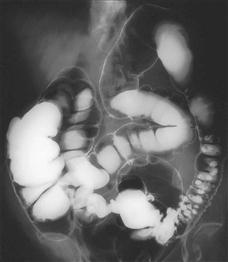Abdominal Pain
Abdominal pain is an extremely common presenting symptom. The pain may be acute (sudden onset) or chronic (lasting for more than a few days or presenting intermittently). It is important to be able to distinguish causes of abdominal pain which need urgent surgery, e.g. ruptured aortic aneurysm, perforated diverticular disease, from those that do not, e.g. biliary colic, ureteric colic, acute pancreatitis. The causes of abdominal pain are legion and the list below contains some of the more common causes but is not intended to be comprehensive.
History
Age
Certain conditions are more likely to occur in certain age groups, e.g. mesenteric adenitis in children, diverticular disease in the elderly.
Pain
■ Time and mode of onset, e.g. sudden, gradual.
■ Character, e.g. dull, vague, cramping, sharp, burning.
■ Constancy, e.g. continuous (peritonitis); intermittent (pain of intestinal colic).
■ Location: where did it start? Has it moved?
■ Radiation, e.g. loin to groin in ureteric colic.
■ Effect of respiration, movement, food, defecation, micturition and menstruation.
Defecation
Examination
General
Is the patient lying comfortably? Is the patient lying still but in pain, e.g. peritonitis? Is the patient writhing in agony, e.g. ureteric or biliary colic? Is the patient flushed, suggesting pyrexia?
Pulse, temperature, respiration
Pulse and temperature are raised in inflammatory conditions. They may also be raised with impending infarction of bowel. An increased respiratory rate might suggest chest infection referring pain to the abdomen.
Cervical lymphadenopathy
Associated with mesenteric adenitis.
Chest
Referred pain from lobar pneumonia.
Abdomen
Rectal examination
Always carry out a rectal examination.
Vaginal examination
There may be discharge or tenderness associated with pelvic inflammatory disease. Examine the uterus and adnexa, e.g. pregnancy, fibroids, ectopic pregnancy.
General Investigations
■ FBC, ESR
Hb ↓ peptic ulcer disease, malignancy. WCC ↑ infective/inflammatory disease, e.g. appendicitis, diverticulitis. ESR ↑ Crohn’s disease, TB.
■ U&Es
Urea and creatinine↑uraemia. Electrolyte disturbances in vomiting and diarrhoea.
■ LFTs
Abnormal in cholangitis and hepatitis. Often abnormal in acute cholecystitis.
■ Serum amylase
Markedly raised in acute pancreatitis. Often moderately raised with perforated peptic ulcer or infarcted bowel.
■ MSU
Blood, protein, culture positive in pyelonephritis. Red cells in ureteric colic.
■ CXR
Gas under diaphragm (perforated viscus). Lower lobar pneumonia (referred pain).
■ AXR
Obstruction – dilated loops of bowel. Site of obstruction. Local ileus (sentinel loop) – pancreatitis, acute appendicitis. Toxic dilatation – dilated, featureless, oedematous colon in ulcerative colitis or Crohn’s disease. Renal calculi. Calcified aortic aneurysm. Air in biliary tree (gallstone ileus). Gallstones (10% radio-opaque).
■ US
Localised abscesses, e.g. appendix abscess, paracolic abscess in diverticular disease. Free fluid – peritonitis, ascites. Aortic aneurysm. Ectopic pregnancy. Ovarian cyst. Gallstones. Empyema, mucocele of gall bladder. Kidney – cysts, tumour.
Specific Investigations
■ Blood glucose
Raised in diabetic ketoacidosis.
■ Serum calcium
Hypercalcaemia.
■ VDRL
Syphilis (tabes dorsalis).
■ Sickling test
Sickle cell disease.
■ Urinary porphobilinogens
Acute intermittent porphyria.
■ ABGs
Metabolic acidosis, e.g. uraemia, infarcted bowel, sepsis, diabetic ketoacidosis.
■ βHCG
Pregnancy. Ectopic pregnancy.
■ ECG
Myocardial infarction (referred pain).
■ OGD
Peptic ulcer. Malignancy.
■ Barium enema
Carcinoma. Volvulus. Intussusception.
■ Small bowel enema
Small bowel Crohn’s disease. Lymphoma of small bowel. Carcinoma of small bowel.
■ Duplex Doppler
Superior mesenteric artery stenosis (mesenteric angina). Superior mesenteric artery thrombosis. Mesenteric venous thrombosis.
■ Angiography
Superior mesenteric embolus or thrombosis.






